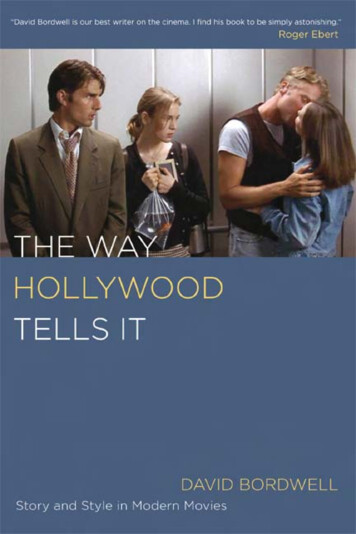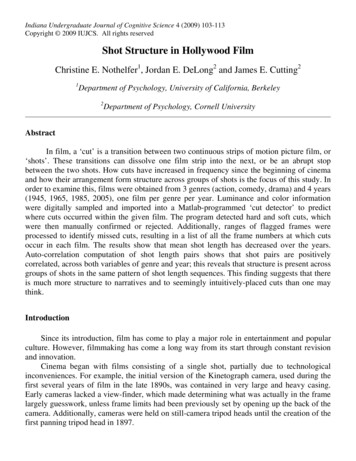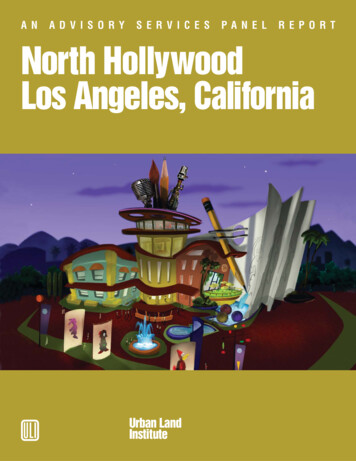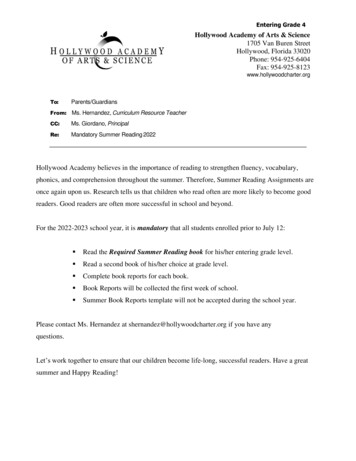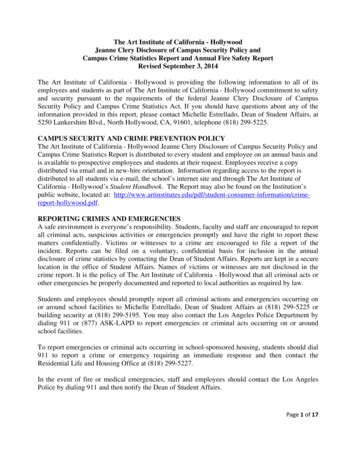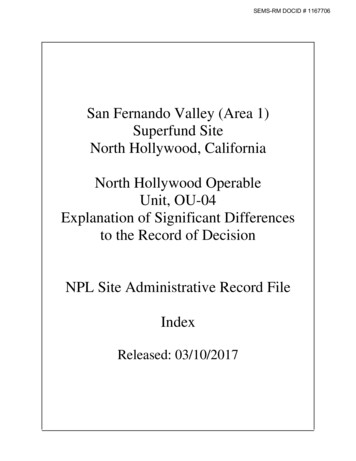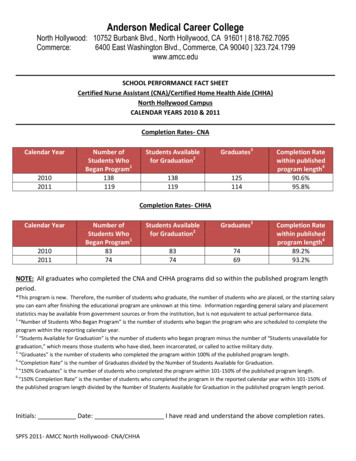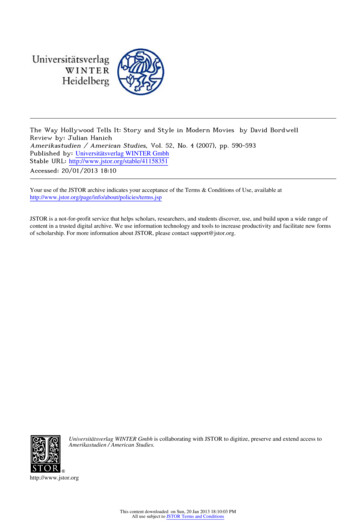
Transcription
The Way Hollywood Tells It: Story and Style in Modern Movies by David BordwellReview by: Julian HanichAmerikastudien / American Studies, Vol. 52, No. 4 (2007), pp. 590-593Published by: Universitätsverlag WINTER GmbhStable URL: http://www.jstor.org/stable/41158351 .Accessed: 20/01/2013 18:10Your use of the JSTOR archive indicates your acceptance of the Terms & Conditions of Use, available at ms.jsp.JSTOR is a not-for-profit service that helps scholars, researchers, and students discover, use, and build upon a wide range ofcontent in a trusted digital archive. We use information technology and tools to increase productivity and facilitate new formsof scholarship. For more information about JSTOR, please contact support@jstor.org.Universitätsverlag WINTER Gmbh is collaborating with JSTOR to digitize, preserve and extend access toAmerikastudien / American Studies.http://www.jstor.orgThis content downloaded on Sun, 20 Jan 2013 18:10:03 PMAll use subject to JSTOR Terms and Conditions
590Reviewsofa whitemanwhois captivatedbyan 'orientalbeauty'and thusrelieson stereotypicalfiguresof sexual and racialOtherness,Brandtarguesthat"thefilmalso seeks to subvertand destabilisetheauthorityofthesemyths"(130). In asimilarway,thougharguingfroma es a senseofambiguityaboutone ofBrowning'sbest-knownfilms,Dracula (1931). She interpretsthefigureof Dracula as the "monstrousOther,"to whichthe culturallyand sociallymarginalizedare drawn,and whichservesas"theembodimentofa ntualvictoryoverthe vampiremayindicatethe West'ssuBronfenarguesthatfacingup to hisperiority,evilpowergeneratesa desireforomnipotencethatreachesa yquality.Finally,Bernd Herzogenrathdevelops aframeworkforhis interprepoststructuralisttationof Freaks (1932),which,again,focuseson a sense of ambiguity.Drawingon Lacan'sfamousnotionof the mirrorstage,the experience of bodily wholenessis connectedirrevocablyto imagesof the fragmentedbody,theillusionofwholehauntingand subvertingness. HerzogenrathrelatesFreaks to a longdiscourseon allegoricalimages of the bodyrepresentingthe American nation, and hestressesthatthefreaks,as a .Thoughthisunusualproductionwas oftenadvertisedas an exploitationsees itasfilm,Herzogenratha Other.As indicated,one of thefewcriticalpointsaboutthisessaycollectionis thechoiceofVivian Sobchack'sresearchexcercise,writtenas agraduatestudentin 1974,as theopening,andin a sense, frame-establishingpiece (Herzogenrathevencalls itthe"introductionproper"[12]to thevolume).Sobchackseemsto anticipate this critique,feelingobliged to prefaceher articlewithan "apologia forthe essay'sindiscriminatedelightat everyscrapof informationI was able to find"(21). In thisrespect,bygivingshortplotsynopsesand by drawingon contemporaneousnewspaperreviews,theas an overessayis r,I believe the book would havereassessprofitedfroma morecontemporarymentofTod Browning'scareerwithinthestudio systemofthe1920sand 1930s.Some ofthedoubtsthatsurfacein variousplaces- wheth-er Tod Browningcan be seen as a orhis creativeoutput(e. g. withLon Chaneyor IrvingThalberg),howwe shouldcontextualize himin the B -moviesector-wouldhavebenefittedfroma morecomplexunderstanding of auteurism,if,indeed,thisis to be themainfocus.But does it have to be? If we aredealing witha 'cult director,'maybethe answerhas to be yes,but the ingand thegeneralfilmculturethatgo beyondanauteuristframework.Some of these connections-such as therelationbetween melodrama and morality,and the stigmatizationof thesensationalism,Other,or the cinema of attractionsand theandproductionofthrills-are well-researchedfairlycommonphenomenain the firstthreedecades ofAmericanfilmhistory.Theycouldhave providedless auteur-centredfruitfullyand thusmoresystemicapproachesto thepeculiaraestheticofTod Browning'sfilmswhichan introductorychaptercould at least havesketchedout. This criticism,however,mustbe seen in perspective.Overall thisvolume,and lovinglydesigned,servesrichlyillustratedas an excellentintroductionto the neglectedfilmsof Tod Browning,drawingon a numberof establishedapproachesbutalso suggestingnewpathsto be id Bordwell, The WayHollywoodTellsIt: Storyand Stylein ModernMovies(Berkeley:U ofCaliforniaP,2006), 298 pp.In 1985,David hat has sincebecome a classic: The Classical HollywoodCinema: Film Style and Mode of Productionto 1960. This magisterialvolume- easilyone of the most thoroughlyresearchedandinfluentialbooks coming out of Americanfilmstudies- trackedthe developmentof adistinct,pervasivefilmstylethatcrystallizedaround 1917. Back then, the three authorsadmittedtheirsomewhatarbitrarydecisionto stoptheiraccountin theyear1960.This iswhereBordwell'snewprojectThe WayHollywood TellsIt comesin. The book takesup thethreadthe year Bordwelland his co-authorshad cutit off,askingtheobvious,yetintriguingquestion:whathas happenedsince?This content downloaded on Sun, 20 Jan 2013 18:10:03 PMAll use subject to JSTOR Terms and Conditions
Reviews591Apart from an introduction,meticulous UnitedStatessincethe1960s,buthas also beennotes,and a useful48-page timetableof the caldistinguishmajor economic and technologicalchanges, aestheticstrategiesthebook containstwoessaysof roughly80 to continuity:rapidediting,use ofextremewide90 pages each. The firstone deals withstory- angle and longlenses,relianceon close shots,cameramovements.wide-rangingtelling;the second one looks at visual style. andconstant,narra- Once again he makesyou see thingsthatyouBothproveBordwellas theoutstandingthathe is. As always, have almostcertainlyoverlooked:David Bortologistandneo-formalistalsohe displaysan intimidatingknowledgeof film dwellis all eyes- whichis, nfluentialshifts(Tosayproduchistory,spottingfor- iconocentrictendencyis morethanmerenittionand technologyand cross-referencinggottenfilms.As always,he rejectsover-the-top picking,a pointthatI willreturnto.)in favorofa piecemealapinferencesWhydid thisnewvisualstylecome lserve ing? Bordwellweaves an intricatenetof reasomer- sons.The smalltelevisionbox notonlyfavorsas a springboardforthe interpretivesaultsofmanylessercritics).And as always,he entlyaccessibly.In themajorityof viewingpositionalso demandsconstantvisualTechnoaround changeto holdtheviewer'sattention.cases he asis:thoseneces- logical innovationslike lightercameras andsary,but sometimestiresomedescriptionsof digitaleditingmade theprowlingcameraandshortshotlengtha muchmorelikelyoption.scenesunderanalysis.wantedIn the firstessay,focusedon storytelling, A youngergenerationof filmmakersforefathersBordwelllists a numberof reasons for the to emulateits proto-intense(e.g.Hol- OrsonWellesand Hitchcock).Et cetera.narrativeinnovationsof contemporaryTo say the least,Bordwellis not an outraof video andlywood.First,the introductionDVD allowed for repeated viewing-and geousaficionadoofHollywood'sversionofinOn theone hand,itcouldthereforesuggested movies that merit re- tensifiedcontinuity.cidivism.Second, a generationof filmmakers be moreelegantand preciselychoreographed:deeplyenmeshedin TV, comic books, video its "aestheticof broad but forcefuleffects,games, and pulp-fictionnovels entered the oftenshowingstrain"(180) clearlypales intradi- comparisonto the counterpartfromHongscene, adapting differentstorytellingtions.A thirdpushthatgotchangegoingwas Kong. On the otherhand, tellingthe tale ofalso implieschroniclingthe need fordistinction.continuityYoungerfilmmakers intensifiedhad to challengethesuperblegacyoftheclas- a narrativeof loss: the rangeof choice is narsical traditioniftheydid notwantto fallinto rowed,excludingotherstylisticoptions,someoblivion. As a consequence, they searched of whichare quite dear to Bordwell.The lossforroads less traveledand began to push the is threefold.First,due to a strongtrustin fastpremises.Formerlydisreputablegenres like editing,thereis practicallyno Americanfilmcrimemovies,science-fiction,fantasyand hor- makerleftwhouses longtakesin theway,say,rorfilmsachievedprominence.The narration Theo Angelopoulos or Michael Haneke do.became more action-driven.The filmsare Second, turningcameraworkand editingintocharacterizedthecreation ng":ofrich,layeredworldsthatcouldbe rummaged not know how to stage actors in space andfordetails.Finally,the 1990sturnedout to be workwithcomplexblocking.1Third,actors'are moreconstrained.The dean "eraofexperimental(73): now performancesstorytelling"thereare "puzzle films"like The SixthSense pendenceon shorttakes and close-upspriviin whicha misleadingnarrativeplaysintricate leges facialexpressionat theexpenseof bodygames with the viewer;there are "network posture,stance,and ShortCuts;and thereare filmswithscrambled1 Thismoreelabargumentis putforwardtimeschemes(Pulp ryoratelyorderstructures(Memento).The secondessayconsistsofa longhardlook of Film Style(Cambridge,MA: HarvardUP,at what Bordwelldubs 'intensifiedcontinu- 1997); and FiguresTracedin Light:On Cinity'-a visualcinematicstylethathas notonly ematicStaging(Berkeley:U of CaliforniaP,becomethedominantwaymovieslook in the 2005).This content downloaded on Sun, 20 Jan 2013 18:10:03 PMAll use subject to JSTOR Terms and Conditions
592Reviewsbattleis foughton theslipthisargumentativeHe lms"havechangedenormousofly" (1). But does thismerittheintroductiona newcategory?Bordwellthinksnot.His mainargumentrestson numbers:moviesthatstandout are fewand farbetween.Fair enough.Yetit does not solve the problem,because filmsthatstickoutdo exist.One hesitatesto tointothesame categoryas The MalteseFalcon,justas a drugdramalikeRequiemnexttofora Dream does not sitcomfortablyThe Man withtheGolden Arm.Even if theyrelyon encesenable verydifferentif we take intoconsiderationtheparticularlyelement that Bordwell igafore-mentionednores: Dolby (surround)sound, foregroundand immersion.3Theingthree-dimensionalityhow farcan one stretchquestionis therefore:a categorybeforeit turnsvague? And: whendoes itbecomehelpfultointroducea newone?intothefieldhasAs one orperceiving,aboutobjectsandbering,talkingand thinkingeventsin the world."4As pattern-recognitiondevicestheyhelpto classifynovelentitiesanddrawinferences.One underlyingproblem is Bordwell'sinsinuationthat post-classicalimplies anticlassical (16). This is not the case. Eleftheriaadmitsthe "strongThanouli,forone, franklyof thisnewparadigmwiththeclasaffiliationsical Hollywoodcinemaand thesense of histhatbindsthem."5Bordwelltoricalcontinuityis rightwhenhe questionsextravagantargumentsaboutradicalshiftsin general.But whynot grantthat some filmsare post-classical(or whatevernotionone prefers),even if the2 Cf. PeterKrämer,"Post-ClassicalHol- majorityis not? At the veryend, Bordwellventures into this direction:lywood,"The OxfordGuide to Film Studies, unwittingly?the 'stylishstyle' of post-1960comparingHillandGibsoned. JohnPamela ChurchAmericancinemato sixteenthcenturyMan(Oxford:OxfordUP, 1998) 289-309;RichardMaltby,HollywoodCinema:An Introduction3 Cf.GianlucaSergi,TheDolby Era: Film(Oxford:Blackwell,2003); Thomas Elsaesserand WarrenBuckland,StudyingContempo- Sound in ContemporaryHollywood (ManraryAmericanFilm:A GuidetoMovieAnaly- chester:ManchesterUP, 2004).4 Edward E. Smithandsis (London: Arnold,2002); RobertBlanchet,Douglas Medin,Blockbuster:Ästhetik,Ökonomie und Ge- Categoriesand Concepts (Cambridge,MA:Kinos (Marburg: HarvardUP, 1981) 1.schichtedes postklassischen5 Thanouli195.Or thinkofElsaesserandSchüren,2003); EleftheriaThanouli, "PostClassicalNarration:A New Paradigmin Con- Buckland's discussionof Die Hard as bothCinema,"New ReviewofFilmand classical and post-classical (Elsaesser andtemporaryBuckland26-79).TelevisionStudies4.3 (2006): 183-96.However,Bordwell'sgoal is not only totrackthechanges-whichhe does withvenerable acuityand rigor-butalso to underscoreIt is herethathisbook becomesthecontinuity.more controversial.Bordwellmaintainsthatthe principlesof the classical systemof nareven ifrationand styleare still flourishing,thefavoredchoiceshave changed:"nearlyallmass-marscenes in nearlyall contemporaryket movies(and in most'independent'films)are staged,shot,and cut accordingto principles thatcrystallizedin the 1910sand 1920s"(180). This is, of course,a broadsideagainstthosefilmcriticsand historianswho dared gmbehindand haveturned'post-classical': fromThomasElsaessertoRichardMaltbyand beyond.2In thesepassages,we encounterBordwell'sfamouspenchantforpolemics- acombinaandenlighteninghighlyentertainingand theboisterouswilltotionoflucidrhetoricUnidefenda position.ApartfromhisformercolleagueNoëlversityof Wisconsin-MadisonCarroll,thereis probablyno filmscholarwritingin theEnglishlanguagetodaywhois moreand eloquentlyopposed to wish-washstronglyand fuzzyconceptsthanBordwell.relativismless antagonisticGranted,Bordwellis slightlythis time.Whoeverwantsto see him in fullthrottleshouldgo back to MakingMeaning:and Rhetoricin 989),an enormouslyon purelyinterpretiveapproaches,or consultwherehis website (www.davidbordwell.net)he picksto pieces the stiltedstyleand overblownargumentsofSlavoj Zizek.Why is he more restrainedthis time? Agood guesswouldbe thatBordwell,so deeplysenses thatsteeped in cognitivepsychology,This content downloaded on Sun, 20 Jan 2013 18:10:03 PMAll use subject to JSTOR Terms and Conditions
Reviewsnerism,he acknowledgesthe existenceof anew style.Renaissance and Mannerismdid,afterall, marktwo distinctart historicalepochs. Justas Manneristartistsdid not throwall priorinsightsoverboard(e.g., centralandso do today'sOliveratmosphericperspective),Stone,Baz Luhrmann,and DarrenAronofsky593stillclingto many(if not all) of the classicalfeatures.Reading Bordwell'shighlyperceptive but at timesunnecessarilydogged bookone gets the impression:this debate is notover.BerlinThis content downloaded on Sun, 20 Jan 2013 18:10:03 PMAll use subject to JSTOR Terms and ConditionsJulianHanich
David Bordwell, The Way Hollywood Tells It: Story and Style in Modern Movies (Berke- ley: U of California P, 2006), 298 pp. In 1985, David Bordwell, Janet Staiger, and Kristin Thompson published what has since become a classic: The Classical Hollywood Cinema: Film Style and Mode of Produc- tion to 1960. This magisterial volume- easily


